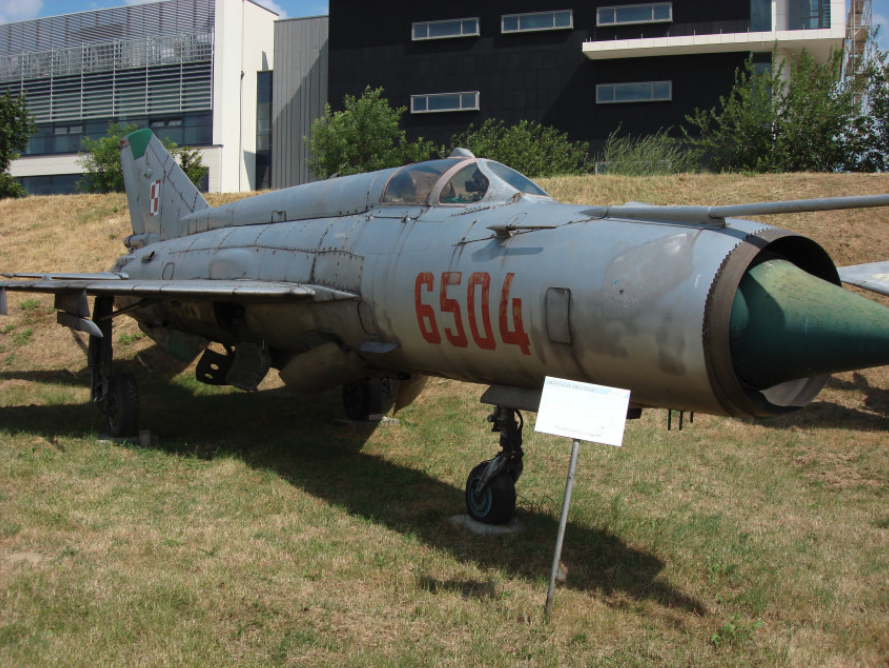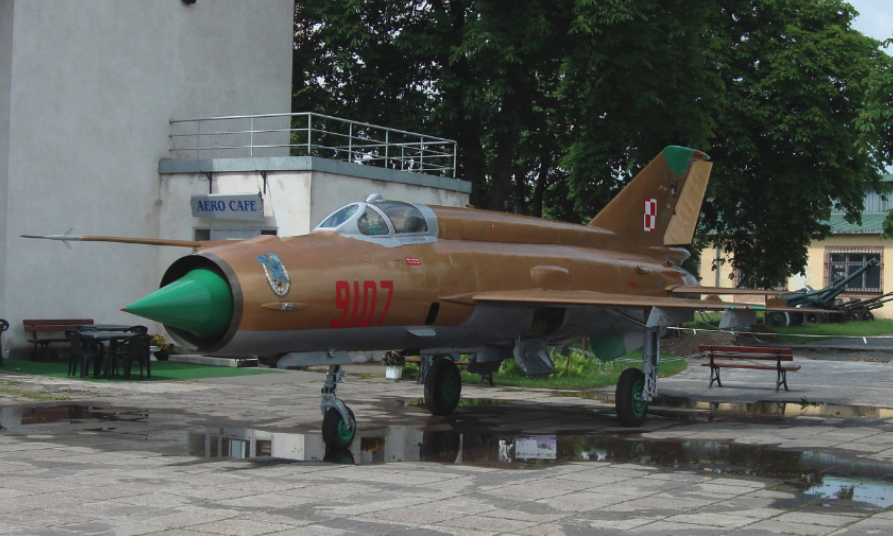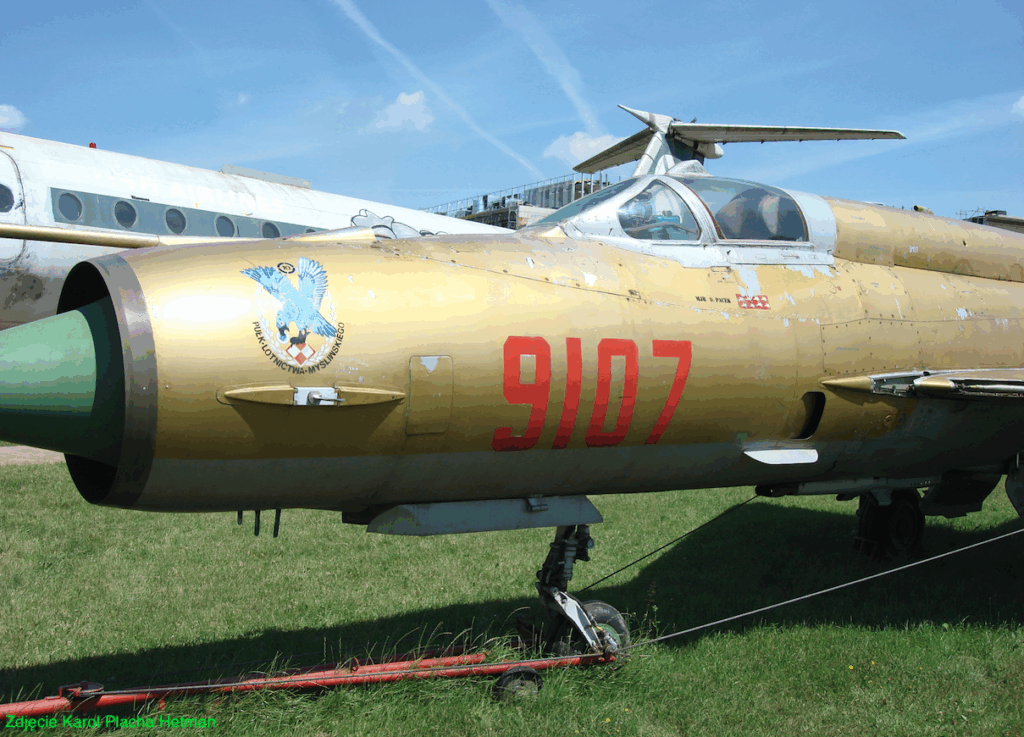Kraków 2007-08-24
232c Section 1961-09-29.
OKB Mikoyan and Gurevich MiG-21 MF in Poland.
The MiG-21 MF is a supersonic fighter aircraft, operating in “all weather conditions”. Aircraft of this version were used in Poland in the number of 120 units.



MiG-21 MF.
The MiG-21 MF type 96 F (A) is a modernized MiG-21 M. It was an export version with the R-13-300 engine and improved equipment. In fact, the changes were minor. In practice, however, many countries purchased this depleted version, and even with R-11 engines. The aircraft was manufactured in Moscow in 1970-1974 and in Gorki in 1975. Despite numerous modifications compared to its predecessors, the MiG-21 MF still belonged to the third generation of MiG-21 aircraft.
MiG-21 MF in Poland. 1972.
Almost simultaneously with the MiG-21 M, the MiG-21 MF type 96 A aircraft were introduced into service. Deliveries lasted from the end of 1972 to 1975. On 11.12.1972, the first 9 aircraft were delivered. Poland purchased a total of 120 (other sources indicate 116) units. In 1990, the Polish Army still had 106 aircraft in this version in service.
Buying MiG-21 MF aircraft may seem strange. We bought depleted versions. Engines and radars as in the MiG-21 M version. (Engine R-11 F2S-300, radar station RP-21 MA). The aircraft have R-11 engines, instead of the more powerful R-13. At that time, the CCCP industry was already producing in large quantities a better version, the MiG-21 bis. In the article – the history of the MiG-21 M – we try to explain this matter.
During the delivery, a batch of MiG-21 MFs from CCCP was brought, in which the quality of the airframe was questioned (Numerous defects. Corrugations of the fuselage sheet metal, where they should have been smooth. Flaps opening unevenly). The division command refused to accept these aircraft. They were sent back to the manufacturer from Malbork. According to unconfirmed information, these aircraft were initially intended for the Vietnam War, but since it ended, they wanted to transfer (sell) the aircraft to Poland. In connection with this, the last batch of 20 MiG-21 MFs was delivered to us exceptionally from the Gorki plant. These aircraft have unusual serial numbers, with the so-called prefix 96A00. The aircraft were accepted on 11.12.1975. These aircraft did not differ from the early delivered MiG-21 MFs. The first MiG-21 MF aircraft were delivered to the 41st PLM in Malbork in 1973-1974. An interesting fact is that the MiG-21 M, MF aircraft used in Malbork were the only ones in Poland that could carry the Ch-66 class P-z and WRe SPS-141 electronic warfare pods.
MiG-21 MF aircraft were introduced to the equipment of the 4th PLM in Goleniów, the 10th PLM in Łask, the 11th PLM in Wrocław, the 26th PLM in Zegrze Pomorskie, the 28th PLM in Słupsk, the 34th PLM-MW in Babie Doły, and the 41st PLM in Malbork.
The MiG-21 MF, UM aircraft arrived in the 10th PLM in Łask relatively late. Training for the new type was carried out using equipment from the 28th PLM and 34th PLM, from which aircraft were temporarily borrowed; 10 MiG-21 MF aircraft and 2 MiG-21 UM aircraft. This was between February and May 1978. The regiment in Łask had to wait for its own aircraft until 1981, when it received 20 MiG-21 MF aircraft from the 26th PLM from Zegrze Pomorskie. These were mainly aircraft manufactured in the Gorki plant. The 10th PLM operated these machines until 1989, when it transferred these aircraft to the 11th PLM in Wrocław.
In 1989, the 10th PLM underwent other changes. All MiG-21 PF aircraft were withdrawn from service, and in their place were introduced older MiG-21 MF aircraft from the disbanded 2nd PLM Kraków in Goleniów, as well as from the 41st PLM from Malbork.
In the period from November 1989 to March 1990, the 62nd PLM received MiG-21 MF aircraft from other regiments, in the amount of 24 aircraft. Mainly from the 11th PLM from Wrocław. The aircraft were 15-18 years old, and their failure rate was high. Therefore, in the spring of 1991, a decision was made to return the older version of the MiG-21 PFM to service. The MiG-21 MF aircraft, operated for over a year, were transferred to the 10th PLM in Łask and the 11th PLM in Wrocław.
In 1991, the 45th Air Experimental Squadron in Modlin had 1 MiG-21 MF aircraft.
In the period from 1991 to 1996, the 10th PLM in Łask took over almost half of the MiG-21 MF aircraft remaining in service.
In August 1998, the air force command decided to rotate the MiG-21 aircraft remaining in service. In October 1998, the 3rd PLM (ex 62) in Krzesiny received MiG-21 MF aircraft from the 41st PLM in Malbork. This was the second time that MiG-21 MF aircraft had visited Krzesiny.
In 1999, the 11th PLM from Wrocław was disbanded. All operational MiG-21 MF aircraft were transferred to the 3rd PLM and 10th PLM in Łask. As a result, all MiG-21 MF still in use were concentrated in these two regiments.
In 1999, Poland was admitted to NATO. As a result, the structure of the air force changed. Squadrons and air bases were established in place of regiments.
On 1 January 2001, the 3rd PLM ceased to exist, and in its place were established the 3rd ELT and 31st BLot. At that time, the 3rd ELT had a dozen or so MiG-21 MF aircraft, which were used until the second half of 2002.
At the turn of 2002/2003, all MiG-21 aircraft were withdrawn from use. During service, 20 MiG-21 MF units were lost (3 in crashes, 16 in failures, 1 due to damage).
MiG-21 MF combat capabilities.
It must be admitted that there were differences in the combat capabilities of the Polish MiG-21 MF and the Russian MiG-21 MF, and it is not just about the engines. We found the following statement by one of the former MiG-21 pilots: “I will give a small example from personal experience. In Astrakhan, I happened to make two flights in “their” MiG-21 MF aircraft. During a tactical exercise, I managed to intercept a target descending from an altitude of 1,200 m to 900 m from a distance of 3 km, and I was above it and descending too! It was barely visible among the ground clutter, and the dust from the sandstorm reached that height, so that visual detection could be forgotten. I flew MiG-21s for over 17 years, I was a flight instructor for 14 years, and I will say this: no aircraft in Poland, even a brand new one (because I flew those too), would be able to do that, even if I saw it with my eyes and put an optical sight reticle on it.” It was the 1980s. This shows that the Soviets were constantly modernizing their avionics equipment. They were uploading new, improved algorithms to the radar stations in use. Whether they offered the upgrades to the Polish side is unknown. But it would certainly have to be paid for.
Until early 1981, the MiG-21 M / MF aircraft, as part of combat duty, were prepared with full armament; 2 x RS-2 US + 2 x R-3 S + 200 pieces of ammunition for the cannon. In 1981, this was changed and the pair on duty was displayed so that one aircraft had 2 x RS-2 US and the other with 2 x R-3 S. An additional pair of missiles was placed on racks by the aircraft. The ammunition for the cannon remained unchanged. The pilots themselves did not really understand this change, but it caused confusion.
The MiG-21 MF was withdrawn from service relatively quickly (1990s) in the former “people’s democracy” countries. But there was one exception, which was Romania. This country was the only one to decide to modernize its MiG-21 aircraft. The decisions were made around 1992. Romania began cooperation with Israeli companies Aerostar (specializing in unmanned aerial vehicles) and Elbit Systems. Far-reaching modernization included MiG-21 M/MF/bis/UM aircraft. On their basis, aircraft designated MiG-21 Lancer were created, which were modified into three versions: Lancer A – intended for close support missions of ground forces, Lancer B – attack, two-seater, Lancer C – air superiority fighter, which was equipped with the Israeli Elta EL/M 2032 radar station. The background of the modernization was to adapt the aircraft to Western standards, allowing cooperation with NATO aircraft. The machines were given the ability to carry R-73 and Python 3 anti-aircraft missiles and Rafael Litening targeting and reconnaissance pods. A total of 36 machines were modernized. The first of these machines took to the air on 23.08.1995. We could see MiG Lancer aircraft in the Republic of Poland in Radom in 2015, just on the 20th anniversary of their introduction into service. The machines were presented at a static exhibition and in the air. This was one of their last displays of Lancer aircraft, as a few months later Romania acquired General Dynamics F-16 A/B Block 15 MLU aircraft from Portugal, which were modified.
Written by Karol Placha Hetman
